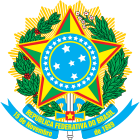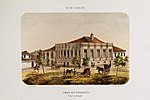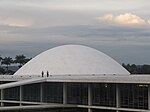Federal Senate (Brazil)
Federal Senate Senado Federal | |
|---|---|
| 57th Legislature of the National Congress | |
 Flag of the Federal Senate | |
| Type | |
| Type | |
Term limits | None |
| History | |
| Founded | 6 May 1826 |
New session started | 5 February 2024 |
| Leadership | |
Government Leader | |
Majority Leader | |
Opposition Leader | |
Minority Leader | |
Female Caucus Leader | |
| Structure | |
| Seats | 81 |
 | |
Political groups | Government (42)
PSD(15)
MDB(11)
PT(8)
PSB(4)
PDT(3)
Opposition (32) PL(13)
PODE(7)
PP(6)
Republicans(4)
PSDB(1)
Independents (7) UNIÃO(7) |
Length of term | 8 years |
| Salary | R$ 33,763.00 (and benefits)[1] |
| Elections | |
| Plurality voting,alternating every four years between single-member elections (FPTP) and dual-member elections (block voting) | |
Last election | 2 October 2022 |
Next election | 4 October 2026 |
| Meeting place | |
 | |
| Senateplenary chamber National Congress building Brasília,Federal District,Brazil | |
| Website | |
| www | |
| This article is part of a series on the |
 |
|---|
15°47′59″S47°51′51″W/ 15.79972°S 47.86417°W
TheFederal Senate(Portuguese:Senado Federal) is theupper houseof theNational CongressofBrazil.When created under theImperial Constitutionin 1824, it was based on theHouse of Lordsof theBritish Parliament,but since theProclamation of the Republicin 1889 and under thefirst republican Constitutionthe Federal Senate has resembled theUnited States Senate.
The currentpresident of the Federal SenateisRodrigo Pacheco,a member of theSocial Democratic PartyfromMinas Gerais.He was elected in February 2021 for a two-year term and re-elected in February 2023 for another two-year term.
Membership[edit]
The Senate has 81 members, serving an eight-yearterm of office.There are three senators from each of the country's 27 federative units, theFederal Districtand the 26states.Elections arestaggeredso that either a third or two-thirds of senators are up for election every four years. Themost recent electiontook place in 2022, where one-third of the Senate was elected.
Elections are held under thefirst-past-the-postandblock votingsystems. In years when a third of members are up for election, voters can cast only one vote and the candidate who receives apluralityof votes within their state is elected. In years when two-thirds of members are up for election, voters can cast two votes. People can not vote for the same candidate twice, but each party can field up to two candidates in each state. The two highest-placed candidates in each state are elected.
History[edit]
The Federal Senate of Brazil was established as theImperial Senateby theConstitution of 1824,first enacted after theDeclaration of Independence.It was modelled on theHouse of Lordsof theBritish Parliament.[2]
Following independence, in 1822,Emperor Pedro Iordered the convocation of a Assembleia Geral Constituinte e Legislativa (Legislative and Constituent General Assembly) to draft the country's first Constitution. Following several disagreements with the elected deputies (which included representatives from present-dayUruguay,then part of the Brazilian Empire under the name ofProvíncia Cisplatina), the Emperor dissolved the Assembly. In 1824, Pedro I implemented the first Constitution which established a legislative branch with theChamber of Deputiesas thelower house,and the Senate as an upper house.
The first configuration of the Senate was a consulting body to the Emperor.Membership was for lifeand it was a place of great prestige, to which only a small part of the population could aspire. The original Senate had 50 members, representing all of theEmpire's provinces,each with a number of senators proportional to its population. In addition to these elected senators,daughters and sonsof the Emperor aged at least 25 were senatorsby right.
The elected members of the Senate had to be at least 40 years old and have an annual income of 800,000contos-de-réis,which limited candidates to wealthy citizens. Voters also faced an income qualification. Voting in an election for the Senate was limited to male citizens with an annual income of at least 200,000 contos-de-réis. Those who qualified for this did not vote directly for senators; instead, they voted for candidates to be Senate electors. To be a Senate elector required an annual income of 400,000 contos-de-réis. Once elected, these electors would then vote for senator. The election itself would not result in a winner automatically. The three candidates receiving the most votes would make up what was called a "triple list",from which the Emperor would select one individual that would be considered"elected".The Emperor usually chose the candidate with the most votes, but it was within his discretion to select whichever of the three individuals listed.
Following the adoption of the 1824 Constitution, the first session of the Senate took place in May 1826. The Emperor had repeatedly delayed calling the first election, which had led to accusations that he would attempt to establish anabsolutistgovernment.
TheProclamation of the Republicin 1889 ended the Brazilian Empire in favor of theFirst Republic.The1891 Constitutionwas then adopted, transforming Brazil's provinces into states and the Senate into an elected body. This was retained under later constitutions, including the current1988 Constitution.Now known as the Federal Senate, it resembles theUnited States Senatein that each state has the same number of senators.
-
Palácio Conde dos Arcos, seat of the Imperial Senate inRio de Janeiro,then Brazil's capital.
-
The Imperial Senate in session, 1888
-
Palácio Monroe,second seat of the Senate.
-
The Federal Senate in theNational Congress buildinginBrasília,capital city of Brazil since 1960.
-
Exterior view of the Senate chamber.
Presiding Board[edit]
The current composition of the Mesa Diretora (Presiding Board) of the Federal Senate is as follows:
| Office | Name | Party | State |
|---|---|---|---|
| President | Rodrigo Pacheco | PSD | Minas Gerais |
| 1st Vice-President | Veneziano Vital do Rêgo | MDB | Paraíba |
| 2nd Vice-President | Rodrigo Cunha | PODE | Alagoas |
| 1st Secretary | Rogério Carvalho | PT | Sergipe |
| 2nd Secretary | Weverton Rocha | PDT | Maranhão |
| 3rd Secretary | Chico Rodrigues | PSB | Roraima |
| 4th Secretary | Styvenson Valentim | PODE | Rio Grande do Norte |
| 1st Substitute | Mara Gabrilli | PSD | São Paulo |
| 2nd Substitute | Ivete da Silveira | MDB | Santa Catarina |
| 3rd Substitute | Hiran Gonçalves | PP | Roraima |
| 4th Substitute | Mecias de Jesus | Republicanos | Roraima |
Composition[edit]
The current composition[3]of the Senate (57th Legislature) is as follows:
| Party | Floor leader | Seats | |
|---|---|---|---|
| Social Democratic Party | Otto Alencar | 15 | |
| Liberal Party | Flávio Bolsonaro | 12 | |
| Brazilian Democratic Movement | Eduardo Braga | 11 | |
| Workers' Party | Fabiano Contarato | 8 | |
| Brazil Union | Efraim Filho | 7 | |
| Podemos | Oriovisto Guimarães | 7 | |
| Progressistas | Ciro Nogueira | 6 | |
| Brazilian Socialist Party | Jorge Kajuru | 5 | |
| Republicans | Mecias de Jesus | 4 | |
| Democratic Labour Party | Weverton Rocha | 2 | |
| Brazilian Social Democracy Party | Izalci Lucas | 2 | |
| New Party | Eduardo Girão | 1 | |
| Independent | Randolfe Rodrigues | 1 | |
| Total | 81 | ||
Current senators[edit]
Standing committees[edit]
| Committee | Chair |
|---|---|
| Agriculture and Agrarian Reform | Alan Rick(UNIÃO-AC) |
| Communication and Digital Law | Eduardo Gomes (PL-TO) |
| Constitution, Justice and Citizenship | Davi Alcolumbre(UNIÃO-AP) |
| Defense of Democracy | Eliziane Gama(PSD-MA) |
| Economic Affairs | Vanderlan Cardoso(PSD-GO) |
| Education and Culture | Flávio Arns(PSB-PR) |
| Environment | Leila Barros(PDT-DF) |
| Ethics and Parliamentary Decorum | Jayme Campos(UNIÃO-MT) |
| External Relations and National Defense | Renan Calheiros(MDB-AL) |
| Human Rights and Participative Legislation | Paulo Paim(PT-RS) |
| Infrastructure Services | Confúcio Moura (MDB-RO) |
| Public Security | Sérgio Petecão(PSD-AC) |
| Regional Development and Tourism | Marcelo Castro(MDB-PI) |
| Science, Technology, Innovation and Computing | Carlos Viana(PODE-MG) |
| Social Affairs | Humberto Costa(PT-PE) |
| Sports | Romário Faria(PL-RJ) |
| Transparency, Governance, Inspection and Control and Consumer Defence | Omar Aziz(PSD-AM) |
See also[edit]
Notes[edit]
References[edit]
- ^Santos, Larissa (11 January 2021)."Saiba quanto ganham os presidentes do Senado e da Câmara".CNN Brasil(in Brazilian Portuguese).Retrieved28 January2022.
- ^"Senado Federal completa hoje 185 anos".R7(in Portuguese). 6 May 2011.Retrieved22 May2012.
O Senado Federal foi criado com a primeira Constituição do Império, outorgada em 1824, inspirado, primeiramente, na Câmara dos Lordes da Grã-Bretanha. Sua primeira reunião ocorreu em 6 de maio de 1826.
. - ^"Lideranças Parlamentares"(in Brazilian Portuguese). Senado Federal.Retrieved17 March2017.
External links[edit]
- Official websiteof the Brazilian Senate (archived 15 June 2014)
- (in Portuguese)Photos 360° of the Brazilian Senate
- List of all Brazilian senators(1826–2011)(in Portuguese)





